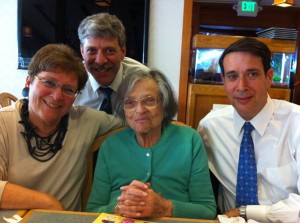Continuum of Care helps family cope with all stages of illness
 July 2012
July 2012
Barbara Barron led a peaceful life in Burlingame for many years, traveling with her husband and welcoming her 10 grandchildren for sleepovers and pancake breakfasts. However, as she grew older, she was stricken with Lewy body disease, a neurodegenerative disorder similar to Parkinson’s that often results in delusions and hallucinations, as well as dementia.
The illness – combined with a number of other physical conditions including diabetes and high blood pressure – resulted in a frustrating series of emergency rooms visits, skilled nursing stays and finally, a permanent home in the memory care unit of an assisted living facility. Early in 2010, Mrs. Barron’s six adult children were advised that their mother qualified for hospice care.
“We hadn’t really talked about it before,” said son Bruce Feder, an attorney who specializes in elder law. “I knew that she wasn’t really healthy, but I didn’t realize she had only six months to live.
As it turned out, she didn’t. In fact, during the next two years, she went on and off hospice care several times. Medicare’s requirement for the hospice benefit is that patients be considered likely to die within six months. Such parameters can be frustrating to family members who simply want their loved ones to continue receiving the comprehensive care that hospice provides.
Carolyn Schwartzbord, Mrs. Barron’s daughter, recalls dreading the news that Mrs. Barron’s condition had stabilized or she had gained weight, because it meant that her mother may no longer qualify for hospice. Another son, Tony Barron, said the family had a big problem with Medicare’s “all or nothing” approach to terminal illness.
“I can’t understand why Medicare does it this way,” he said. “It’s not like someone is cured of cancer and doesn’t need care anymore.”
Fortunately, although Mrs. Barron didn’t always qualify as a hospice patient, she continued in Mission Hospice’s care through the Transitions “pre-hospice” program. She and her family continued to have access to the staff, as well as volunteer visitors, during periods when Mrs. Barron was too well for hospice. When Mission Hospice introduced the Advanced Care (home care) program, Mrs. Barron qualified.
“Every patient is unique, and every illness progresses differently. That’s why our continuum of care model is so important. It allows us to provide patients like Mrs. Barron the same high quality care and the same familiar faces, regardless of where they are in that last stage of life,” said social worker Karri Kaiser.
The family also negotiated a protocol with Mrs. Barron’s assisted living caregivers about what would happen during emergency situations, so that she wasn’t subjected to upsetting tests or travel. Schwartzbord said the caregivers were relieved that they could call Mission Hospice at any time with questions or concerns, as well as the family.
Feder said that the family felt that Mission Hospice consistently treated his mother as “someone that they wanted to do well,” rather than one of many patients.
“Every time decisions were being made, I felt like they were all on our side,” he said. “They were all advocates for our mom. It never felt like we were fighting a bureaucracy. You can’t take that for granted in health care these days. They never disappointed us.”
